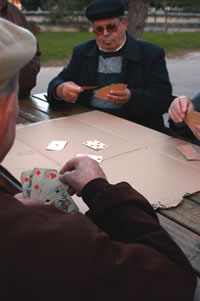Grey Eyes
by Federico Bartolomei, picture by Attilio Ruffo
The sight prevention program for older adults.
The World Health Organization
has been repeating for years that low vision, in its present state, represents a
priority for health services of all countries. It is estimated that
approximately 11 million people in Europe have low vision and one million are
blind.
Among
the causes of blindness in industrialized countries, infectious diseases have
diminished, but the so-called degenerative forms of blindness have significantly
increased because of aging and accidents.
The reasons for this are numerous.
The first reason is certainly the progressively ageing population (in Italy, it
is estimated that there are three older adults for one child).
Moreover,
recent studies indicate that the number of people over 65 will more than double
between 1995 and 2030; consequently, it is estimated that visual disabilities
are expected to drastically increase with time. Blindness usually increases 20
times past the ages of 65 to 90. Basically, for people between the age of 65 and
74, there is a prevalence rate of 0.4-0.8% and 2.3% and more for those who are
75 years old and over.
Prevention means to act before the diagnosis of a
disease and in ophtalmology there are many pathologies that can be adapted to
prevention programs,  individually as
well as collectively.
individually as
well as collectively.
However, the frequent conditions of poverty, solitude,
abandonment, depression and psychophysiological decline, often present in
ageing, can influence heavily the possibility of an early diagnosis, of adequate
therapy and making sure that all precautions are taken to preserve sight.
In
this context, Grey Eyes, the sight prevention program, was introduced. It is
coordinated by the Institute for the Blind F. Cavazza, in collaboration with
ANCESCAO, within the framework of activities relating to Project C.I.F.R.A. and
funded by the Fondazione Cassa di Risparmio in Bologna.
During the whole
month of February, free visits were made to detect potential sight problems in
community clinics done in four social centres for citizens: Baraccano, Villa
Paradiso, Villa Torchi, Santa Viola. Through this initiative, it was possible to
see close to 17,500 persons.
The adopted protocols allowed the early
diagnosis of the following diseases: glaucoma, macular degeneration, and very
often, visual problems associated with the use of inappropriate corrective
lenses (old glasses or ones that are not prescribed for the user's
needs).
Bologna's Institute of Optics and Optometry has contributed
significantly to the program. As a matter of fact, numerous professionals, who
work in clinics and are members of the Union of Optical Clinics of
Bologna's ASCOM have participated in the screening project following a rigorous
training program offered by the Istituto Superiore di Ottica ed Optometria
Benigno Zaccagnini. The activities of the opticians and optometrists of Bologna
have been supported by two important companies specialized in lenses for glasses
Essilor and Hoya, and allowed those who did not own corrective lenses to acquire
some at set lower prices.